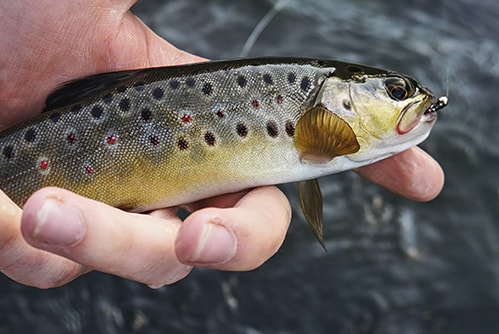Floppy Flies
Back when most fly fishers had never heard of nymphs, or Mr. Skues, before WWII, a forward-looking Orvis catalog listed what was described as “All Purpose Nymphs” in three basic colors and a variety of sizes. They were all based on the profile we now associate with a Gold Ribbed Hare’s Ear.
The sizes ranged from #10 to #16. They were tied with the same materials. But the way those materials worked in the water was very different. The larger flies moved a bit in the currents, simulating life. The smaller ones were much stiffer, and therefore more resistant to being animated by water. The “floppier” flies caught more fish. Our fly tying materials vary a great deal in softness. We pick Marabou for its ability to wave around and give the impression of a leech. We use Grouse and Hen neck feathers for soft hackles. We try to find the stiffest, most web-free hackles for dry flies, and the softest deer or elk hair for Caddis imitations. We often forget that our beautifully tied flies are meant to appear alive, in and on the water.
I remember a young, talented fly tier who delighted in exacting imitations of insects that had bent legs, gossamer wings, properly uplifting tails, and even the correct number of abdominal segments. At the fly shop, we’d “ooh” and “aah.” As impressive as those flies were, they were designed for human wonderment, not the hungry eyes of trout. So what is a “Floppy Fly?” An insect imitation that appears alive when set in motion by river currents. This means that as the size of an imitation decreases, the mobility and softness of the materials used increases.
Some years ago, I was tested by a dual-hatch situation that occured on the Lamar River in Yellowstone Park. It was October, and the first snowflakes of the year fell gently on my nose and on the water. When the sun shone, tiny Baetis, #20, suddenly covered the riffle and trout fed avidly. When the sun was obscured by clouds, the small insects ceased hatching, and I was treated to large Gray Drakes, Siphlonurus in size #8. In addition to having to modify my leader and tippet to fish the two different hatches, the day was alternating between clouds and sun about every twenty minutes. But the selective fish fed only on the predominant insect, ignoring the other species that had been hatching only minutes before.
My solution in both cases was a soft hackle in the right colors, fished in the film to those rising Cutthroats. Both were dark gray. Both were tied on dry fly hooks, and had a collar of soft hackle from a Sage Grouse — I used two large hackles on the bigger fly. The smaller fly was dubbed with wispy Muskrat underfur; the larger one, #10 had much stiffer dark Hare’s Ear. And the fish ate them both.
When we tie streamers and bucktails, it is important to use feathers in smaller sizes, and hair in larger ones, because the feathers are floppier, and work in the water to imitate a living minnow. When you tie underwater flies, the “floppy quotient” of your materials should increase as the size of the fly decreases.


